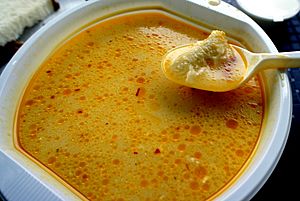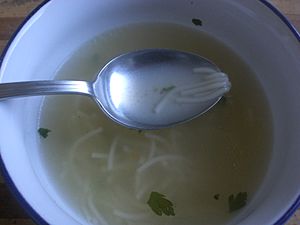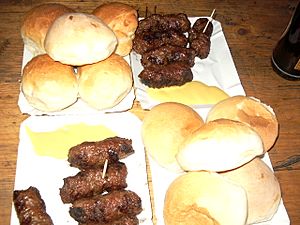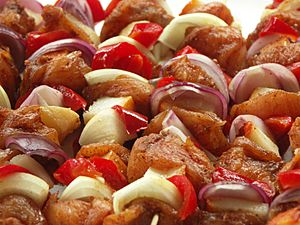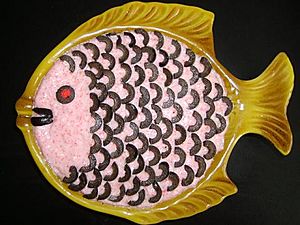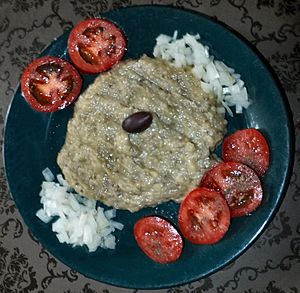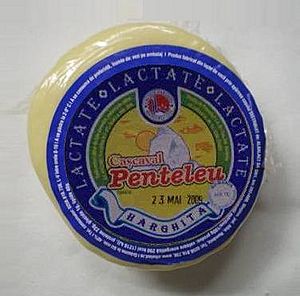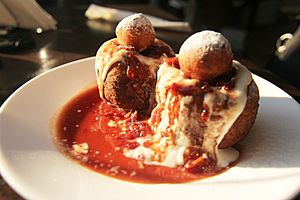Romanian cuisine facts for kids
Romanian cuisine (Bucătăria românească) is a mix of different dishes from many traditions. It has been influenced by Turkish cuisine, countries in the Balkans, Hungarian cuisine, and other parts of Central Europe. But it still has its own special taste!
Romanian food includes many dishes for holidays, depending on the season and celebration. This is because the country has strong ties to the Eastern Orthodox Church. Romanian meals often use vegetables, grains, fruits, honey, milk, dairy products, and different kinds of meat.
There are many types of dishes. For example, ciorbă is a general name for many soups that have a special sour taste. These soups can have meat, vegetables, or fish. They are made sour with things like lemon juice, sauerkraut juice (zeamă de varză), vinegar, or borș (which is traditionally made from bran). Another important term is țuică, which is a traditional plum brandy in Romania.
Contents
History of Romanian Food
Long ago, in 1841, two people named Costache Negruzzi and Mihail Kogălniceanu put together a cookbook. It was called "200 tried recipes for dishes, pastries and other household things." Negruzzi also wrote that in old Moldavia, fancy food wasn't common. Even a big feast might only have a few dishes. After a sour soup called borș, Greek dishes cooked with herbs and butter would be served, and then other international meat dishes.
Cheese has been a part of Romanian food for a very long time. Brânză is the Romanian word for cheese. It comes from an ancient language called Dacian. The Dacians were early people in Romania. Their traditional food included healthy vegetables like lentils, peas, spinach, and garlic. They also ate fruits like grapes, apples, and raspberries. The Dacians made a lot of wine. At one point, a Dacian king named Burebista was upset that his warriors drank too much wine, so he cut down the grapevines!
Later, the Romans brought new ideas for pastries made with cheese, such as alivenci, pască, or brânzoaice. They also introduced different ways to make millet porridge.
After they arrived in Europe, Maize (corn) and potatoes became very important foods in Romanian cooking. Corn, especially, helped Romanians become healthier and better fed in the 1500s and 1600s. This led to a big increase in the population.
For about 300 years, two old Romanian regions, Wallachia and Moldavia, were influenced by their neighbors, like the Ottoman Empire. Ottoman cuisine brought new appetizers made from vegetables like eggplant and bell peppers. They also brought different ways to prepare meat, such as chiftele (fried meatballs, similar to kofta). Many soups like ciorbă and meat-and-vegetable stews like iahnie de fasole (beans), ardei umpluți (stuffed peppers), and sarmale (stuffed cabbage) were influenced by Turkish cuisine. Even the Romanian tomato salad is a version of the Turkish çoban salata.
What Romanian Food is Like
Romanian recipes show the same influences as the rest of Romanian culture. The Turks brought meatballs (perișoare in a meatball soup). From the Greeks came musaca. The Austrians brought șnițel. Romanians share many foods with the Balkan area and the old Austria-Hungary region. Some dishes are truly original or can be traced back to the Romans and other ancient cultures. It's hard to know the exact origin of many dishes because there aren't many old written records in Eastern Europe.
One of the most common meals is mămăligă, which is similar to polenta. It can be eaten by itself or with other dishes. Pork is the main meat used in Romanian cooking. But beef is also eaten, and lamb or fish dishes are very popular too.
Before Christmas, on December 20 (called Ignat's Day), many families in the countryside traditionally prepare a pig. A variety of foods for Christmas are made from the pig, such as:
- Cârnați – pork sausages with garlic, which can be smoked or dried.
- Lebăr – a sausage made from liver, which can be smooth like pâté or have a coarser texture.
- Sângerete (black pudding) – a sausage made from pig's blood mixed with fat, meat, breadcrumbs, and spices.
- Tobă (head cheese) – made from pig's feet, ears, and meat from the head, set in aspic (a jelly) and stuffed into the pig's stomach.
- Tochitură – a stew with pork, smoked and fresh sausage, cooked in a tomato sauce. It's served with mămăligă and sometimes a little wine. There are many versions of this stew, some with different meats like chicken, lamb, beef, or pork.
- Pomana porcului—pan-fried pork cubes served right after the pig is prepared. This is to thank family and friends who helped.
- Piftie/răcitură – parts of the pig like the tail, feet, and ears, spiced with garlic and served in aspic.
- Jumări – crispy bits of pork left after rendering the fat, often seasoned with spices.
The Christmas meal often ends with the traditional cozonac, a sweet bread. It can have fillings like nuts, poppy seeds, or rahat (Turkish delight).
At Easter, lamb is often served. Main dishes include borș de miel (lamb sour soup), roast lamb, and drob de miel. Drob de miel is a Romanian-style lamb haggis made from minced offal (like heart, liver, lungs), lamb meat, and spring onions with spices. It's wrapped in a special membrane and roasted. The traditional Easter cake is pască, a pie made from yeast dough with a sweet cottage cheese filling in the middle.
Romanian pancakes, called clătite, are thin like French crêpes. They can be filled with savory things like ground meat or cheese, or sweet things like jam. Different recipes are made depending on the season or special events.
Wine is a very popular drink in Romania. Romanian wine has been made for over 3,000 years! Romania is one of the world's largest wine producers. They make many local types of wine, as well as international kinds. Beer is also popular, especially light pilsener beer, which has German influences. Romania also has old breweries.
Romania is the world's second largest producer of plums. About 75% of Romania's plum harvest is used to make the famous țuică, a plum brandy.
Eating without Meat or Animal Products
People who follow the Romanian Orthodox Church often have fasting periods throughout the year. During these times, they eat a diet without any animal products. This means that many vegan foods are easy to find in stores and restaurants. However, Romanians might not be familiar with vegan or vegetarian diets as a full-time choice. Many traditional recipes have versions that are suitable for vegans, and the Vegetables section below lists many common fasting foods.
List of Dishes
Soups
- Borș is fermented wheat bran. It's used to make ciorbă sour. Sometimes, "borș" is used to mean "ciorbă" today.
- Ciorbă is the traditional Romanian sour soup.
- Ciorbă de burtă (tripe soup), with sour cream, egg yolks, garlic, and vinegar.
- Ciorbă de perișoare (meatball soup).
- Ciorbă de fasole cu afumătură (bean and smoked meat soup).
- Ciorbă de legume (vegetable soup).
- Ciorbă de pește „ca-n Deltă” (fish soup made in the style of the Danube Delta). Traditionally, water directly from the Danube River is used.
- Ciorbă de praz is a leek soup.
- Ciorbă de pui is a chicken soup.
- Ciorbă de lobodă is a red orach soup.
- Ciorbă de salată cu afumătură (green lettuce and smoked meat soup) with sour milk.
- Ciorbă de sfeclă, also called Borș de sfeclă or Borș rusesc (similar to Borscht).
- Ciorbă de urechiușe, a sour soup with wild mushrooms.
- Ciorbă moldovenească de găină is a hen sour soup.
- Ciorbă țărănească (peasant soup), made from various vegetables and any kind of meat (beef, pork, lamb, chicken, fish).
- Storceag, fish soup with sour cream and egg, made sour with vinegar or lemon juice.
- Supă (a general name for sweet, usually clear, soups). These are made from vegetables alone or with chicken or beef. The difference between Supă and Ciorbă is that in Supă, the meat and most vegetables are removed. The clear liquid is then served with dumplings or noodles. Some sour soups, which use lemon juice, are called Supe a la grec (Greek soups).
- Supă (de pui) cu găluște (clear dumpling soup with chicken broth).
- Supă (de pui) cu tăiței (clear noodle soup with chicken broth).
Meat Dishes
- Caltaboș / chișcă - a cooked sausage made from minced pork organs and rice, onions, herbs (like dill), and spices, stuffed in a pig's casing.
- Cârnați - a garlicky sausage, often smoked, as in Fasole cu cârnați (beans with sausages).
- Chiftele - small meatballs covered with breadcrumbs or flour.
- Drob de miel - a lamb haggis made from minced organs wrapped in a special membrane and roasted like a meatloaf. This is a traditional Easter dish.
- Frigărui - Romanian-style shish-kebab (meat skewers).
- Limbă cu măsline - cow tongue with olives.
- Mititei (mici) - grilled minced meat rolls, traditionally made from lamb, but often from mixed meats (pork, veal, lamb) with many spices (garlic, thyme, pepper, paprika, etc.).
- Grătar (usually made with "mici") - grilled pork or beef with seasonings.
- Musaca - an eggplant, potato, and meat pie.
- Ostropel - a way of cooking chicken or duck or any meat. It's slow-cooked fried meat in a tomato sauce.
- Papricaș - Chicken paprikash made with bell pepper and paprika.
- Gulaș - Goulash, a stew made with potato and beef.
- Pârjoale - a type of meatball larger than chiftele, originally from the Moldova region.
- Piftie - pork stock is simmered until it thickens, then spiced with garlic and paprika. Boiled pork meat is added, and it's left to cool. The cooled liquid becomes a jelly.
- Pleșcoi sausages - a special Romanian sausage.
- Rasol - boiled beef, often served with a garlic paste called mujdei.
- Salam de Sibiu - a type of salami.
- Sarmale - minced meat with rice, onions, and herbs, wrapped in pickled cabbage leaves or vine leaves. They are boiled for a few hours in water with tomato paste. There are also many vegan versions.
- Slănină - pork fat, often smoked with paprika, herbs, and pepper.
- Șnițel - a pork, veal, or beef breaded cutlet (like a Viennese schnitzel).
- Stufat - lamb, onion, and garlic stew.
- Tobă - pork sausage (usually pig's stomach, stuffed with pork jelly, liver, and skin).
- Tocană/tocaniță - meat stew.
- Tocăniță vânătorească - venison (deer meat) stew.
- Tochitură - pan-fried cubed pork, fresh salty cheese (brânză de burduf or telemea), fried eggs, and sausages served with mămăligă and sometimes wine.
- Varză călită - fried cabbage with pork ribs, duck, or sausages.
- Virșli - a type of sausage made from a mix of goat or lamb with pork.
Fish Dishes
- Chiftele de pește - fish meatballs.
- Crap pane - breaded carp fillet.
- Ghiveci cu pește - fish stew with vegetables.
- Macrou afumat - smoked mackerel fillet.
- Novac afumat din Țara Bârsei - smoked carp fillet.
- Pană de somn rasol - catfish in brine with garlic.
- Plachie din pește - ragout (stew) of river fish with vegetables.
- Papricaș de pește - fish papricaș.
- Salată de icre - roe (fish eggs) salad, traditionally made from carp, pike, or other fish, mixed with onion.
- Salată cu icre de știucă de Tulcea - a type of roe salad.
- Salata tradițională cu icre de crap - another type of roe salad.
- Saramură de crap - carp in brine.
- Scrumbie de Dunăre afumată - smoked pontic shad.
Vegetable Dishes
- Ardei umpluți - stuffed bell peppers with meat, rice, and onions.
- Dovlecei umpluți - stuffed zucchini.
- Gulii umplute - stuffed kohlrabi.
- Vinete umplute - stuffed eggplant.
- Sarmale - stuffed cabbage rolls, also made from grape or dock leaves.
- Ghiveci - Romania's national dish; a vegetable stew similar to Bulgarian gjuvec and Hungarian lecsó.
- Ghiveci cǎlugăresc - vegetable stew prepared by nuns in monasteries.
- Fasole batută - bean paste made from Romanian refried beans. It uses white or Cannellini beans, with olive or sunflower oil and minced garlic. It's usually served with fried onions.
- Mămăligă - cornmeal mush, also known as Romanian-style polenta. Mămăligă can be a side dish or the base for other meals, like mămăligă cu lapte (polenta with hot milk), bulz (baked polenta with Romanian sheep cheese and sour cream), or mămăliguță cu brânză și smântănă (polenta with telemea (Romanian cheese similar to feta) and sour cream).
- Mâncare de mazăre - pea stew.
- Mâncare de praz - leek stew.
- Pilaf - a dish of rice, vegetables, and sometimes pieces of meat. The meat is often chicken, pork, or lamb. It's cooked similarly to risotto.
- Chifteluțe de ciuperci - chiftele made from mushrooms instead of meat.
- Șnițel de ciuperci - mushroom fritter.
- Tocană de ciuperci - mushroom stew made with fried mushrooms, garlic, and dill (sometimes sour cream is added).
- Tocăniță de gălbiori - chanterelle mushroom stew.
- Zacuscă - a vegetable spread made from roasted eggplant, sautéed onions, tomato paste, and roasted red peppers, cooked slowly.
List of Salads
- Ardei copți - roasted pepper salad, with vinegar and sunflower oil.
- Murături - different fruits and vegetables preserved by pickling.
- Castraveți murați - pickled small cucumbers with dill, garlic, and parsley root.
- Gogonele murate - pickled green tomatoes, a simpler version of murături asortate.
- Varză murată - cabbage pickled in salty water, flavored with dill stalks and beetroots for a red color.
- Murături asortate - mixed pickled vegetables. This can include onions, garlic, green tomatoes, peppers, cucumbers, kohlrabi, beets, carrots, celery, parsley roots, cauliflower, apples, quince, unripe plums, small unripe watermelons, small zucchini, and red cabbage. They are usually preserved in salty water or vinegar.
- Mujdei - a crushed garlic sauce, made from garlic, salt, oil, and water. Lemon or tomatoes can be added for a milder taste.
- Salată de boeuf - minced boiled meat with boiled vegetables, mayonnaise, and pickles.
- Salată de vinete - roasted and peeled eggplant, chopped onions, and salt mixed with oil or mayonnaise.
- Salată orientală - potato salad with eggs, onions, and olives.
- Salată de sfeclă - beet salad.
- Salată de roșii - tomato salad, with sliced onions, bell peppers, and cucumber. Flavored with dill or parsley.
- Shopska salad - also known as Bulgarian salad. It's made from tomatoes, cucumbers, onion/scallions, raw or roasted peppers, telemea cheese, and parsley. The vegetables are usually diced, salted, and lightly dressed with sunflower/olive oil and vinegar.
List of Cheeses
The general name for cheese in Romania is brânză. It is thought to come from the ancient Dacian language. Most cheeses are made from cow's or sheep's milk. Goat's milk is not used as often. Sheep cheese is considered "the real cheese," though some people today prefer not to eat it because it can be fattier and have a stronger smell.
- Brânză de burduf is a soft cheese made from sheep's milk. It's traditionally stuffed into a sheep's stomach and has a strong taste.
- Brânză topită is a melted cheese, a general name for processed cheese made in factories.
- Brânză în coșuleț is a sheep's milk cheese with a strong taste and soft texture. It's stuffed into fir tree bark instead of a pig's bladder and lightly smoked. It's a traditional product.
- Caș is a soft, fresh white cheese, unsalted or lightly salted, stored in salty water. It's eaten fresh and cannot be stored for a long time. It's a traditional, seasonal product.
- Cașcaval is a semi-hard cheese made from sheep's or cow's milk. It's a traditional product. Cașcaval de Săveni is a special type of cașcaval.
- Penteleu, a type of cașcaval, is a traditional product.
- Năsal cheese is a type of cheese with a strong smell, a traditional product.
- Șvaițer, a factory-made cheese (like Swiss cheese).
- Telemea, a white cheese made from cow's or sheep's milk, similar to feta. The traditional "Telemea de Ibănești" and "Telemea de Sibiu" are special types of telemea. "Telemea de Covurlui" is spiced with Nigella damascena seeds, which gives it a unique flavor.
- Urdă - made by boiling the liquid left over from making cheese (whey) until the remaining proteins come together. It's a traditional product.
- Zămătișe - a type of cottage cheese.
List of Desserts
- Alivenci, a corn and cheese pie that can be sweet or savory. It's a traditional dessert in Eastern Romania and Moldova.

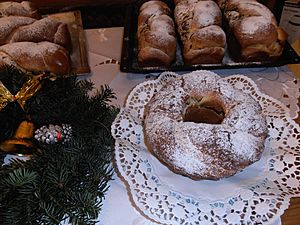
- Amandine - chocolate sponge cake with almond and chocolate filling, covered in chocolate glaze.
- Brânzoaice (Poale-n brâu moldovenești) - traditional Moldavian soft cakes filled with sweet cheese.
- Chec - pound cake.
- Clătite - thin pancakes.
- Colivă - boiled wheat mixed with sugar and walnuts. It's often decorated with candy and icing sugar and shared at memorial ceremonies.
- Colțunași - dumplings.
- Cornulețe - crescent-shaped pastries filled with jam, chocolate, cinnamon sugar, walnuts, or raisins.
- Covrigi - pretzels.
- Cozonac - a sweet bread similar to Stollen, made from dough with milk, eggs, sugar, butter, and other ingredients.
- Cremă de zahăr ars - Crème brûlée (a creamy dessert with a hard caramel top).
- Găluști cu prune - dumplings with plums, a dessert made of mashed potatoes and flour dough, filled with fresh plums.
- Gogoși - like "doughnuts," but more similar to fried dough.
- Griș cu lapte - semolina pudding with milk.
- Halva - a sweet treat.
- Joffre cake - a special cake created at the Casa Capșa restaurant in Bucharest.
- Lapte de pasăre - literally "bird's milk," a vanilla custard with "floating islands" of whipped egg whites.
- Magiun of Topoloveni - a type of plum jam.
- Mucenici/sfințișori - sweet pastries shaped like the number "8," made from boiled or baked dough. They are decorated with walnuts, sugar, or honey and eaten on March 9th.
- Orez cu lapte - Rice pudding.
- Pandișpan - Sponge cake.
- Papanași - a type of doughnut made from sweet cheese, eggs, and semolina. They are boiled or fried and served with fruit syrup or jam and sour cream.
- Pelincile Domnului - a Moldavian pie made of thin honey-flavored wheat cakes and hemp seed cream.
- Plăcintă - traditional pastry.
- Plăcintă dobrogeană - a type of plăcintă.
- Prăjituri - assorted pastries.
- Chocolate salami - salam de biscuiți (literally "salami of biscuits"). It's made from biscuits, chocolate, and rum flavor. Its cylindrical shape makes it look like a sausage.
- Savarine - a type of sweet cake.
- Scovergi - flat fried dough. It's eaten with honey, jam, or cheese.
- Șarlotă - a custard made from milk, eggs, sugar, whipped cream, gelatin, fruits, and ladyfingers. It comes from the French dessert Charlotte.
- Tort - cake.
- Turtă dulce - gingerbread.
List of Drinks
- Afinată - a sweet drink made from afine (similar to blueberries).
- Bere - beer.
- Cafea - coffee.
- Ceai - tea. This can be herbal teas like chamomile, mint, or linden flower. Or it can be common black tea, called ceai rusesc (Russian tea), often served at breakfast.
- Horincă is a plum or apple fruit drink, made in northern Romania.
- Must - grape juice that is fermenting but not yet wine.
- Pălincă is a fruit drink, often made from plums, apples, apricots, peaches, or pears, produced in Transylvania.
- Pelin de mai is a special wine, usually made in spring, flavored with dried Artemisia plants.
- Rachiu is a fruit drink. "Rachiu" can be made from any fruit (except plums), while "țuică" is specifically for plum brandy.
- Rachiu de tescovină is a fruit drink made from grapes that have been used to make wine, similar to Italian grappa.
- Sana is a type of drinkable yogurt.
- Secărică is a caraway fruit flavored drink, similar to German kümmel.
- Sirop - sweet drinks made with syrup from fir trees, pine, buckthorn, blueberry, raspberry, or strawberry, with different types of honey or sugar.
- Socată is a non-alcoholic drink made from fermented elderflower.
- Șliboviță is a plum brandy, made in the Banat region.
- Turț is a plum brandy, named after the village of Turț in northwestern Romania.
- Țuică is a plum brandy.
- Vin - wine.
- Vișinată is a sour cherry drink.
- Vodcă - vodka.
- Zmeurată is a raspberry drink.
|
See also
 In Spanish: Gastronomía de Rumania para niños
In Spanish: Gastronomía de Rumania para niños



